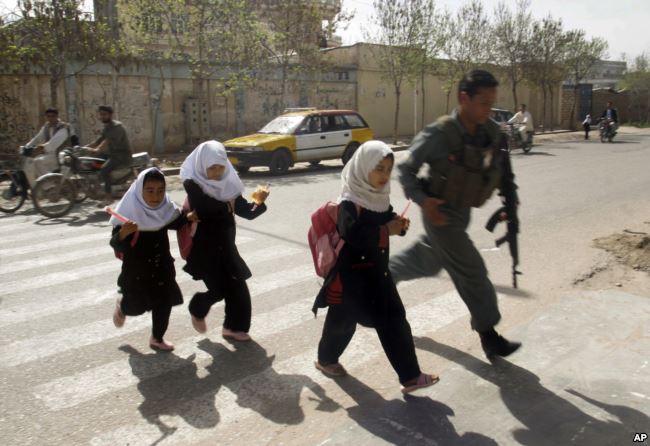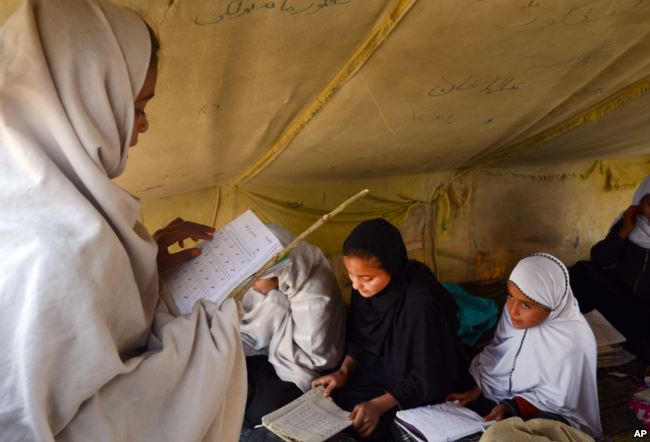VOA – Afghan provincial officials reported a rise in girls’ enrolment rates across eastern Nangarhar Province, despite constant attacks and threats by Islamic State and other militant groups in the area.
“Of the 14,000 graduates last year, we had 3,000 girls. This year, 4,000 girls graduated out of the total 18,000 graduates,” said Mohammad Asif, a spokesperson for the department of education in Nangarhar.
Asif added that girls constituted 45 percent of the 820,000 total students in the province.
Girls are traditionally deprived of education in Afghanistan’s remote areas and were not allowed to go to school when the Taliban was in power.
FILE – An Afghan policeman walks with school girls across the road in Herat, west of Kabul, Afghanistan, March 16, 2010.
Decades-long conflict in the country has had negative effects on education, but there has been improvement in the last 15 years, with millions of students including girls, returning to school.
Urban and rural disparities
Analysts say more girls are attending school in urban areas than in rural parts of the province.
“The number has risen in urban centers but girls in several remote districts are still unable to attend school,” said Malalai Shinwari, an advisor to President Ashraf Ghani and a civil society activist.
Girls in many rural and remote regions are faced with multiple societal and security challenges, including lack of infrastructure for schools in certain areas.
“There are no schools for girls in many areas in Nangarhar,” Shinwari said. “In some areas girls are only able to attend home-based schools, which receive little support from the government.”
“In many areas girls do not go to school because there is no school nearby,” Haroon Rashid Sherzad, a civil society activist from Nangarhar and former deputy minister of narcotics, told VOA. “Huge distances to the nearest schools discourage parents from sending their daughters to school.”
Increasing security threats have also kept girls out of schools in many areas where educational institutions have been a soft target of terrorist groups.
IS militants, who are active in several districts of Nangarhar, have shuttered classrooms, particularly for girls, in areas under their control.
“The situation in remote areas is worrisome. Militants’ presence is a serious challenge to girls’ education,” Sherzad said.
Another issue is the lack of female teachers, as many parents hesitate to send their daughters to school with male teachers.
“The lack of qualified female teachers is a major obstacle to the girls’ education in many districts as the socio-cultural pressure that girls be taught by female teachers limits girls’ access to education,” said Shinwari, who hails from Nangarhar’s Achin district where IS has established a strong footprint for the past two years.
“The government should generate enough female teachers in rural and remote areas,” the presidential advisor added, suggesting that the government should hire women teachers from nearby areas and arrange for their daily commute to schools. “Parents and local elders too should speak up for their girls’ educational rights,” she said.
FILE – Afghan students attend class in a tent in Jalalabad, capital of Nangarhar province, Afghanistan, Dec. 16, 2015. Analysts say by targeting students and education centers, militants are aiming at the heart of the society.
The ratio of female teachers is still low in certain areas of the country. According to Nangarhar provincial government estimates, of the 15,500 teachers in the province, only 1,400 are women.
Education authorities say they are in the process of hiring new women teachers for remote districts in the province.
VOA’s Zabihullah Ghazi contributed to this report from Nangarhar.




